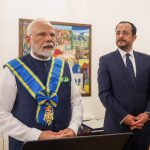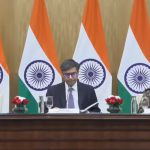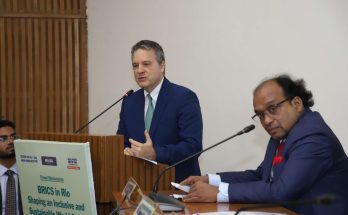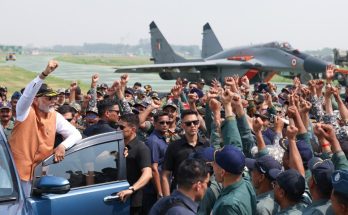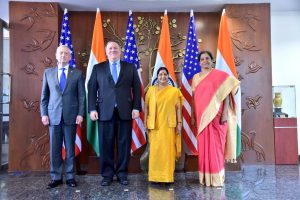
Get your maths right. In the evolving arithmetic and calculus of India-US relations, 2+2 could add up to more than just 4. The 123 moment, crystallised in the transformational civil nuclear deal, is now already more than a decade old. The defining partnership of the 21st century, as Barack Obama christened it famously, is now itching for a new “Trump-et” and seems poised to move into a higher ‘456’ orbit at the inaugural 2+2 dialogue between foreign and defence ministers of the two countries in New Delhi on September 6.
Great Expectations
The messaging from both sides is distinctly upbeat on the eve of the 2+2 dialogue: Washington has already laid out an ambitious agenda to operationalise India’s status as US’ Major Defence Partner. Officials and US-friendly strategy gurus in New Delhi are trying to mint a new idiom of special relationship and point out that the US has 2+2 dialogue only with closest allies like Japan and Australia. In their view, the decision to hold 2+2 dialogue is in itself the big takeaway as it reflects the growing strategic importance India and the US attach to each other.
What’s on the table?
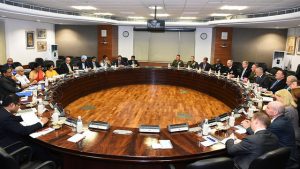
What it all adds up to is that there are high expectations and high stakes as India’s External Affairs Minister Sushma Swaraj and Defence Minister Nirmala Sitharaman sit down for talks with their American counterparts, Secretary of State Mike Pompeo and Defence Secretary James Mattis in New Delhi this week.
Taking an informed long view, what can be realistically expected from the much-trumpeted 2+2 talks? First and foremost, the 2+2 dialogue will cement India’s status as the US’ leading strategic and security partner in the region. The US has already signalled rising importance of India by elevating it to Strategic Trade Authorisation-1 (STA-1) list, the third Asian country in this exclusive club, besides Japan and South Korea. The STA-1 status follows from the 123 deal and enables seamless sale and transfer of high-end defence trade and cutting-edge technologies to India by cutting through bureaucratic labyrinth.
Defence, the next big frontier
Second, a slew of concrete steps and initiatives will be unveiled to operationalise India’s status as US Major Defence Partner, which was granted during the Obama regime and was re-affirmed by the Trump administration, marking a continuity in robust bipartisan strategic consensus in Washington to promote India’s rise as a major global power.
The defence-related deliverables could include a hotline between Indian and US ministers for defence and foreign affairs, enhanced collaboration in defence innovations and posting of an Indian Navy liaison officer at the US Naval Forces Central Command (NAVCENT) in Bahrain. The 2+2 dialogue will also mark an upgrade of the US status as a preeminent source of weaponry for India, with the planned procurement of a host of high-end platforms estimated to be around $5-8 billion. These include, among others, the procurement of 24 MRHs (multi-role helicopters) and the US National Advanced Surface-to-Air Missile System-II (NASAMS-II), which will protect the national capital New Delhi from a nuclear strike.
To COMCASA or Not
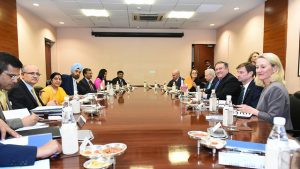
To fructify the promise of value-added defence partnership, the US is pushing India hard to sign the Communications, Compatibility and Security Agreement (COMCASA), which will enhance interoperability between the militaries and military systems of India and the US.
The draft text is ready for signing, and awaits the Cabinet’s approval. The overarching concern in India is to ensure that the pact is not misused for spying on India or in any way which will compromise India’s sovereignty and vital security interests. The US side considers these apprehensions as misplaced and have tried to reassure their Indian interlocutors that foundational agreements like COMCASA are underpinned by trust. However, given that the elections are only a few months away, one is not sure whether the Modi government will take the plunge, at least for now, as it could provide extra fodder to opposition parties and critics to sharpen their attack on the alleged erosion of India’s strategic autonomy. In such a situation, the signing of COMCASA looks unlikely at the 2+2 dialogue; at best, there could be in-principle approval to the crucial pact.
Navigating the Indo-Pacific
Third, the 2+2 dialogue is expected to clarify and enhance the scope of India-US collaboration in the Indo-Pacific through various plurilateral and multilateral options, including the Quadrilateral Dialogue of democracies.
The decision to re-name US Pacific Command as Indo-Pacific Command and a vigorous defence of the use of “Indo-Pacific” phrase instead of “Asia Pacific” by the powers-that-be in Washington underline that India is pivotal to shaping a free, open and inclusive Indo-Pacific. In his defining address at the Shangri-La Dialogue in Singapore on June 1, PM Modi pitched robustly for an inclusive Indo-Pacific. Both India and US have officially denied China containment as the driving force behind their enhanced Indo-Pacific collaboration, but a sceptical Beijing will be closely scanning the 2+2 dialogue, with a touch of paranoia.
Elephants in the room
Going forward, the 2+2 dialogue will not be just about India and US. In fact, there will be 4 elephants in the room at the 2+2 talks in New Delhi. The world will be metaphorically on the table, but one can expect special focus on the four countries – China, Russia, Iran and Pakistan – which have been problematic countries for the US, posing a different set of challenges for India.
On Pakistan, Trump, for all his famed unpredictability, has gone much beyond his predecessors to mount unprecedented pressure on Rawalpindi to curb cross-border terror. Just ahead of 2+ 2 dialogue, the US suspended $300 million in military aid for Pakistan. As Pompeo arrives in New Delhi after a trip to Islamabad, India will be closely listening in to what he says about Pakistan’s new Prime Minister Imran Khan and his views on relations with India and terrorism.
Creative diplomacy will be tested in finding a way around continuous issues involving third countries. There are barely a couple of months to go before the November 4 deadline for US sanctions and zero imports of Iranian oil kicks in. Given Iran’s criticality to India’s energy security and the strategic significance of the relationship, India is hoping that the US will be more realistic and provide at least a limited waiver to India for importing Iranian oil. India is also expecting the US to ring-fence the Chabahar port from the sanctions on strategic grounds as the port transcends commerce and is critical to stability in Afghanistan.
Similarly, India will be expecting the US to make an exception for India to allow it to purchase Russian S-400 system to bolster its deterrence. In tricky and fraught situations like these, diplomacy has to live up to its calling as the art of the possible.
The Road Ahead
Probably, there will be no public announcements on these sensitive issues, but one only hopes that the ‘456’ vision of India-US partnership can inspire Washington and New Delhi to find a middle way around these challenging issues in the long-term interest of nurturing and elevating this mutually empowering partnership of the 21st century to the next level. In the end, the 456 phase of India-US relations will be underpinned by a concord of liberal democratic values and a convergence between strategic interests of the US and India’s global aspirations. In mapping the way ahead, India and the US will have to focus on twinning of Indian and American dreams by accelerating people-driven engagement and forging an enduring innovation-focused partnership in areas of education, science and technology, clean energy and public health that visibly impact the lives of ordinary people. It’s only by taking people along that 2+2 will add up to more than 4.
(Manish Chand is CEO and Editor-in-Chief of India Writes Network and India and World, a magazine focused on global affairs)
Author Profile

- Manish Chand is Founder-CEO and Editor-in-Chief of India Writes Network (www.indiawrites.org) and India and World, a pioneering magazine focused on international affairs. He is CEO/Director of TGII Media Private Limited, an India-based media, publishing, research and consultancy company.
Latest entries
 India and the WorldJune 16, 2025Amid Pakistan-Turkey nexus, Cyprus joins India against cross-border terror
India and the WorldJune 16, 2025Amid Pakistan-Turkey nexus, Cyprus joins India against cross-border terror India and the WorldMay 8, 2025Pahalgam payback: India exposes Pakistan’s lies, misuse of religious sites for training terrorists
India and the WorldMay 8, 2025Pahalgam payback: India exposes Pakistan’s lies, misuse of religious sites for training terrorists India and the WorldMay 3, 2025IMEEC provides a democratic alternative to BRI: Italy’s former foreign minister (Interview)
India and the WorldMay 3, 2025IMEEC provides a democratic alternative to BRI: Italy’s former foreign minister (Interview) India and the WorldApril 21, 20253T Template for India-US Mega Partnership
India and the WorldApril 21, 20253T Template for India-US Mega Partnership

